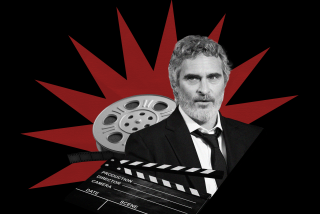Stepping Into Filmmaker’s ‘Safe’ World : Movies: Todd Haynes’ poetic, disturbing second feature deals with an allergic reaction to modern products. It’s his move toward the mainstream.
NEW YORK — At 11 a.m. in a West Village cafe, filmmaker Todd Haynes is a time-warped eyeful at a too-small bistro table, looking like David Bowie, circa 1972.
A polyester shirt pulled taut across his chest under a faded Wrangler denim jacket, stovepipe jeans with mega-cuffs over Doc Marten stompers, he’s working a glam rock look that’s so dead-on it’s jarring, even in this been-there-done-that environ. The hair is killer: spiked and dyed red, with long wispy sideburns creeping down his pale white cheeks and enough fringe in back to cover his jacket collar.
Passersby slow to study him wondering: How much is that Diamond Dog in the window? One woman, a casting agent trawling for redheads, even stops by and gives him her card.
His current wardrobe, he says, is sartorial research for a rock ‘n’ roll period piece he’s writing--”it’s interesting and cool . . . and so different from today’s gay uniforms.” Haynes’ appearance belies the seriousness of the film he’s promoting, the environmental horror movie called “Safe” that stars Julianne Moore and opens today.
His second feature, the film unflinchingly deals with a mysterious immunity disorder called 20th Century Disease, an allergic reaction to everything from beauty products to food additives to air pollution. As Moore’s character, an unremarkable woman imprisoned by her suburban Los Angeles surroundings, says: “Our beautiful new couch? Totally toxic.”
It’s an AIDS metaphor, sure, set in the kind of community in which the openly gay filmmaker grew up (Encino). But “Safe” is also an examination of alternative healing, empty materialism and our entire culture, which the writer-director says is totally toxic and “deeply addictive at the very same time.”
The film shows that even in privileged white suburbia, disease can strike. “I really wanted to make a film that targets people who make AIDS someone else’s issue,” Haynes says. Multiple Chemical Sensitivity, as various U.S. government agencies call this true-to-life disability, “is a more neutral playing field” than AIDS.
Like his first feature, “Poison”--which took the Grand Jury Prize at Sundance in 1992 and was subsequently denounced by the Christian Right for its homoerotic content and its National Endowment for the Arts funding--and his infamous 1988 film “Superstar: The Karen Carpenter Story” starring Barbie dolls (and banned from distribution after legal action by famous sibling Richard Carpenter), “Safe” is trancelike, poetic and disturbing.
“It’s a different kind of experience than we’re usually accustomed to in films,” Haynes, 34, says. “It makes me cry, parts of it.” He isn’t kidding himself into thinking it’s popular fare--”I assume the biggest audience will be an art-house audience,” he says--but “Safe” is a move toward the mainstream for Haynes’ decidedly underground sensibility. The film is being released by Sony Pictures Classics, and, unlike “Poison,” boasts a lead actress whose name goes above the title. Moore, who took the role in “Safe” because she thought the role was “one of the best I’ve ever read,” was featured in “Short Cuts,” “Vanya on 42nd Street” and “The Fugitive.”
Those who know her work from those films, however, may find themselves feeling quite unsafe after seeing “Safe.” Hope evaporates quicker than the exhaust fumes that catapult Moore’s Los Angeles housewife Carol White into a lifetime of disease-battling misery and New Age guru-ism.
Lighthearted fun it’s not, which may be one reason it took Haynes four years to get financing for the project, despite his notoriety and the critical success of “Poison” and the fact that “Safe” cost less than $1 million. Although he complains about not making much money from his films, Haynes won’t abandon his love of on-screen experimentation in favor of more audience-friendly fare.
“I don’t want to make people feel better,” he says. “I have a hard time making movies that affirm life and say life is a good and happy place. That’s not true about the world. Right now it’s a really scary time. The political climate is constricting daily. I’d love to feel more hopeful, I really would.” But he just can’t.
Despite such glum talk, Haynes is not a pill in person. He’s quite fun, actually--an intellectual who lives in Brooklyn and has had a lover, Jim Lyons, for the last six years. His Angst and pain he saves for the screen. “Films give me a place to put that,” he says.
Although his films can be heart-wrenching, especially in their depiction of childhood, Haynes says he grew up without “any external problems. I had really loving parents and a happy childhood. I wasn’t abused. My parents are very supportive and proud. My grandfather and my uncle put big chunks of money into ‘Poison.’ My parents came to Cannes [with “Safe”] and had more fun than I did.” Haynes’ father owns a sales company; his mother is an interior designer. They live in California.
Asked about his role in the so-called New Queer Cinema, Haynes says, “I still consider myself a gay filmmaker. I just don’t think it’s a requirement for a gay filmmaker to make films about gay life.” Besides, he says, “Hollywood’s now making gay films all the time, so maybe we can make films about all kinds of things . . . even nightmares of heterosexual depravity.”
Or glam rock, as Haynes is doing with his next feature, tentatively titled “Velvet Goldmine.” “I think there will be more pleasure and more fun in that one,” he says. Certainly it won’t be safe.
More to Read
Only good movies
Get the Indie Focus newsletter, Mark Olsen's weekly guide to the world of cinema.
You may occasionally receive promotional content from the Los Angeles Times.










